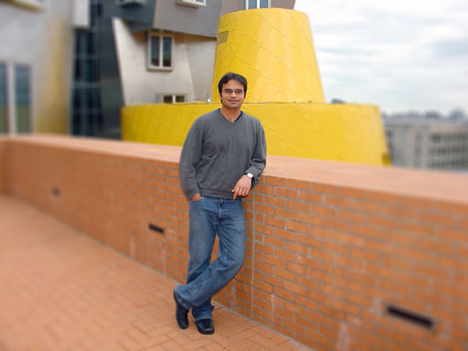There’s a new face on the LIDS faculty: Prof. Devavrat Shah, as approachable as he is bright, comes to us from India by way of California. He’s now called the lab home for almost a year, but he’d been here just four months when LIDS-All had the opportunity to talk with him. The short length of time aside, he already described the environment as “wonderful, fantastic, better than I expected.” Devavrat joins the communications and networks group, or as he puts it, steps under the “umbrella of communication” at LIDS. Before this, he was a post doc at Stanford University (Statistics) and the Mathematical Sciences Research Institute, after finishing his PhD at Stanford. He spent his undergraduate years at the Indian Institute of Technology in Bombay, which he jokes wasn’t far from his hometown “by Indian context,” at five hours by train.
At first, Devavrat studied as a computer science/math student, interested in number theory and cryptography. While working on his PhD, he was exposed to new ideas that sparked his interest in networks and applied probability, which eventually led to his current work. Devavrat is especially interested in looking at the behavior of interacting particle systems, and using it to understand large, man-made networks. True to LIDS, it’s an interdisciplinary and pioneering approach.
To better understand this new method, it’s important to take a look at network scheduling. In basic terms, communication networks transfer “packets” of information from one node—a certain location—to another. Physical constraints restrict us doing this arbitrarily, so networks must be planned, and users need to know the best way to transfer information. Yet few people are interested in making these decisions actively. Picture one node sitting in New York, and another in San Francisco: users at each end don’t want to consult each other before sending an email or making a phone call. Now imagine trying to “schedule” that network, and accomodate everyone’s needs. It’s no small task, and researchers use different approaches to tackle the problem. Looking at particle systems is one interesting method. Like users in a communication network, particles behave independently, yet a whole system functions in balance with this seemingly random behavior. Devavrat and his colleagues are working to create algorithms that could affect the behavior of the particles – and thereby, the components of a network – so they produce a desired result.
Why particles? Most of us learned about atoms in high school chemistry classes, and the tiny particles, like electrons, that compose them. Those particles hold a great deal of interest for researchers, and not only for reasons you might expect. Physicists and mathematicians have long studied “interacting particle systems,” which are essentially a group of particles that react to each other. Some particles are likely to spin up, and others, to spin down. Physicists are interested in studying the overall picture, or meta-state of these particles. They want to know, for example, how many spin upwards, and how often? Statisticians come up with mathematical tools to study this behavior, and these tools can model similarly complex engineering systems. That is, natural systems can be used to help analyze and design man-made systems, like networks.
The implications of being able to not only imitate, but actually engineer particle systems, are fascinating. Devavrat explains that the new approaches are “very promising.” Modeling natural particle systems could also provide overarching techniques that are applicable to many different questions, not just those related to networks. As Devavrat puts it, this could be “like a big hammer, and we use that same hammer for all sorts of nails.” The “particle systems approach” has been used to solve certain optimization problems in the past; in fact, the idea has been around for twenty-odd years. Researchers have used it for various simulations. Now, however, a set of new algorithms can illuminate “more sophisticated connections” between particle systems and engineering applications. Devavrat mentions artificial intelligence as one example, as well as his own area: networks.
Such research has broad implications in the communications industry. Simply put, it could solve major network scheduling problems. Devavrat point outs that while this is his focus, other fields are equally interested. The approach already has effects for people who use highly efficient coding mechanisms, for example. In general, it is most applicable to large-scale, complex systems, which are inherently harder to engineer. Very large networks, for instance, are difficult to design based on predictions about individual users’ behavior. Sophisticated mathematical techniques are needed in order to do so.
Devavrat’s research mirrors its counterparts in LIDS because it is at once theoretical and applicable to the “real world.” When searching for a faculty position, Devavrat was drawn to LIDS for what he calls its “interesting multifaceted personality.” He liked its combination of various research areas, as well as its joint focus on fundamental theory and applied properties. This “symbiosis” is very important to Devavrat, and is just one of the reasons he fits so well here.
Of course, his transition from sunny, suburban Palo Alto to Cambridge was a little strange in the beginning. Devavrat names the dress code—not the academics—as one major difference. He recounts with a smile that people at Stanford often wear flip-flops and shorts, whereas those at MIT “are very stylish.” He’s quick to add that students and faculty at both universities are “great.” He is already settling happily into life on this coast, along with his wife, Salvia, who will soon start her residency at the New England Medical Center of Tufts University. LIDS welcomes him and is certainly glad he made the move east.




